February 1, 2013
Air Date: February 1, 2013
FULL SHOW
SEGMENTS

The Quest for GMO Labeling
View the page for this story
Three months ago, Prop 37, a California ballot measure to mandate the labeling of GMO foods was defeated, partly due to fierce lobbying from the food industry. But similar initiatives are underway in other states, including Vermont, New Mexico, and Washington, and the food industry may be less opposed. Trudy Bialic, Public Affairs Director at PCC Natural Markets in Seattle tells host Steve Curwood that agriculture exports are so vital to Washington State she feels GMO labeling is vital. (05:55)
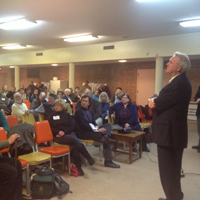
Capitol Hill Pollution Under Fire
/ Jeff YoungView the page for this story
In 2009, Jeff Young reported on protests against the use of coal at the Capitol Power plant, which supplies energy to Capitol Hill. The plant has taken steps to transition towards natural gas, yet it still burns coal. Now DC City Councilman Tommy Wells wants to pass legislation that would prohibit the burning of coal inside the city forever. He joins host Steve Curwood to explain. (07:20)

Booming Coal Exports Threaten the Great Barrier Reef
View the page for this story
UNESCO is threatening to take the Great Barrier Reef off its list of World Heritage sites in the wake of Australia’s decision to build new coal transport facilities on the Queensland coast. Tim McDonnell of Mother Jones magazine's Climate Desk joins host Steve Curwood to explain how an increase in shipping could damage the vulnerable reef. (06:00)

Space Trash to Space Treasure
View the page for this story
Astronauts on extended missions in space create a lot of waste. John Fisher, a scientist with NASA's Bioengineering Branch tells host Steve Curwood that the agency has crafted a way to recycle the waste into tiles that can serve as radiation shields. (04:50)

The Fight to Save Old Logger’s Path
/ Reid FrazierView the page for this story
Pennsylvania is a central location of the fracking industry, and some environmentalists hoping to protect an area of natural beauty have found a mystery over its status. Reid Frazier reports. (07:05)

Burning! A Longer US Fire Season May Be the New Normal
View the page for this story
2012 was an extreme year for wildfires, and overall fire season now lasts about 75 days longer than forty years ago. Jason Sibold, geography professor at Colorado State University, tells host Steve Curwood that the longer fire season is causing fires in areas that haven’t burned in at least 800 years. (06:25)
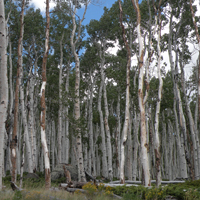
The World's Largest Known Organism In Trouble
View the page for this story
The world’s largest and possibly oldest living organism is Pando, a Quaking Aspen clone in Utah. Karen Mock, Professor of Molecular Ecology at Utah State University tells host Steve Curwood that precise estimates about the age of Pando are not currently possible, but it may be many thousands of years old. But according to Paul Rogers of the Western Aspen Alliance, over grazing from deer and elk are now threatening the massive tree's existence. (09:35)
Show Credits and Funders
Show Transcript
HOST: Steve Curwood
GUESTS: Trudy Bialic, Tommy Wells, Tim McDonnell, John Fisher, Jason Sibold, Paul Rogers, and Karen Mock
REPORTERS: Jeff Young, Reid Frazier
[THEME]
CURWOOD: From Public Radio International, this is Living on Earth. I'm Steve Curwood. California voters turned down labels for genetically-modified foods; now Washington state has certified a GMO ballot initiative to protect its valuable food markets abroad.
BIALIC: So wheat and apples is a huge part that the underpinnings of our economic fiscal health in this state. If we label things here, we will have a much better chance of protecting our export markets.
CURWOOD: And food giants are rethinking their opposition to labels. Also, what's really happening with plans to drill for gas in a Pennsylvania forest loved and treasured for its beauty.
KISBERG: Well it was last summer; it was someone calling me to say, what’s going on in Rock Run? There's...the frackers are up there. They’re all over the place.

Rock Run drains a portion of Loyalsock State Forest, in North-Central Pennsylvania. (Photo: Reid R. Frazier)
CURWOOD: Unravelling the mystery of who's in charge - and what's been agreed. We’ll have those stories and more on Living on Earth. Stick around.
[THEME]
[MUSIC: Boards Of Canada “Zoetrope” from “In A Beautiful Place Out In The Country” (Warp Records 2000)]
ANNOUNCER: Support for Living on Earth comes from Stonyfield Farm.
[THEME]
The Quest for GMO Labeling

Trudy Bialic
CURWOOD: From the Jennifer and Ted Stanley Studios in Boston, this is Living on Earth. I'm Steve Curwood.
Last fall, agribusiness and giant food firms mounted a fierce lobbying effort to defeat a California ballot measure requiring the labeling of genetically modified organisms. But now they may be changing their approach. Monsanto CEO Hugh Grant told the Wall Street Journal he is - quote - "up for a dialogue about labeling", even though the company spent more than $8 million dollars to defeat the California measure.
Sources tell Living on Earth that Wal-Mart recently convened a private meeting of major food companies including Pepsi, Coca-Cola, and Mars to discuss how a federal GMO label might be developed to preclude a patchwork of state rules. Alaska already has a law on GM fish labeling, and Vermont, Missouri, New Mexico and Connecticut are considering action. February 1st, Washington state certified a GMO ballot initiative.
Trudy Bialic, Director of Public Affairs at PCC Natural Markets, has been working on the initiative, and joins me now from Seattle, Washington.
BIALIC: The key issue here in Washington most of all, really, is labeling the genetically engineered salmon that’s about to be approved by FDA. The fishing industry doesn’t even want genetically engineered salmon approved. But if it’s approved, at least give them labeling to protect the identity, the integrity, and the value of the wild salmon industry that we have here – the commercial fishing industry.
This labeling law is the backup to what the fishermen are asking for, and frankly, for what the apple growers are asking for. The apple growers, theWashington Apple Commission, the USDA, the US Apple Association, both have come out publicly opposing genetically engineered apples. They’re already planted here in Washington state, so is genetically engineered wheat. This is upsetting to a sector that depends on having products they can sell to countries that are sensitive to genetically engineered foods and require labels.
CURWOOD: How much money are we talking about? How big is this export business?
BIALIC: A third of the apple crop here in Washington state produces 60 percent of the nation’s domestic supply. But it also has 30 percent of the total crop going overseas. Wheat, on the other hand, is our largest commodity export. It’s right after Boeing in terms of value, and ahead of Microsoft in terms of export value. So wheat and apples is a huge part that the underpinnings of our economic fiscal health in this state. If we label things here, we will have a much better chance of protecting our export markets.
CURWOOD: Now, I understand representatives of many of the major food corporations recently held a meeting to discuss the question of a federal rule on GMO labels. People who’ve been at those meetings confirm that the meeting happened. What would that mean? What does that mean to you...those meetings going on?
BIALIC: Well this topic is clearly on the top of the agenda for many in the chemical and pesticide industry, and it’s on the top of the agenda for many in the...let’s say the convenience or snack food or junk food industry also. So it’s something definitely they don’t want customers to know that there are genetically engineered ingredients in their products. And so they’re trying to figure out how they’re going to navigate this. That’s pretty much all I can surmise from it.
CURWOOD: But why would the food industry shift so dramatically on this issue to start talking about...well, gee, maybe there’s going to be a rule...what should this rule be?
BIALIC: I just think they see the writing on the wall. I think we’re going to get labeling. It’s not a matter of if. It’s a matter of when. And so they’re logically trying to figure out what their position is going to be, and how they’re going to navigate it.
CURWOOD: Now, a few years ago there was a debate about labeling Bovine Growth Hormone in milk. But now the label essentially indicates now only certain products do not contain Bovine Growth Hormone. What kind of a food label do you think the food industry might be pushing for and what do you think consumers should have?
BIALIC: I’m glad you brought up the voluntary labels. And you’re right about milk. Voluntary labeling puts the responsibility on the wrong party. And the problem is, most supermarkets in this country and most consumers do not have access to the products, that say, produced without GMO foods. People want to know, our customers in particular want to know, which foods actually contain or are genetically engineered foods. The voluntary non-GMO label is not what they’re asking for. What they’re asking for is a declaration of the content of the foods they are buying – just like foods are labeled to reflect how much cholesterol, how much sodium, whether orange juice is from fresh or concentrate. It’s simply a label of more information.
CURWOOD: How confident are you that this initiative petition will pass in Washington state?
BIALIC: We’re the underdog. There’s no question about that. We just don’t have the kind of money that the chemical and pesticide industries do; we never will. Until we can get a level playing field for our electoral system, and there isn’t a 5-to-1 disproportionate funding in a run like we have in California; the opposition to labeling outspent proponents. They just have more money. Chemical companies, pesticide companies, giant junk food companies have a ton more money than grassroots folks. We’re just everyday folks and farmers and fishermen. We don’t have those kinds of resources. So, yes, we are the underdog. And it is formidable; it doesn’t mean you don’t give it a go. It doesn’t mean you don’t stand up and say, “this is the right thing to do”. And it’s not just a foodie issue. This affects real people. It affects their livelihood. It affects their fiscal health.
CURWOOD: Trudy Bialic, Director of Public Affairs at PCC Natural Markets in Washington state. Thanks so much, Trudy.
BIALIC: Thank you.
Related links:
- Text of Washington State ballot initiative: I-522 "The People's Right To Know Genetically Engineered Food Act"
- More about Trudy Bialic
- Remarks of Monsanto CEO Hugh Grant in Wall Street Journal January 29, 2013
[MUSIC: Meshell Ndegeocello “Feelin Good” from Pour une ame souverine – A Dedication To Nina Simone (Naïve Records 2013)]
Capitol Hill Pollution Under Fire

DC Councilman Tommy Wells speaking at a meeting of concerned residents of the neighborhood around the Capitol Hill Power Plant (photo: tommywells.org)
CURWOOD: Cheap and plentiful coal generates about 45 percent of global energy-related CO2 emissions, as well as dangerous particulates linked to thousands of deaths each year in the US alone. Coal use in the US has been dropping sharply over the past few years, but still, just a few blocks from where President Obama gave his inaugural address last month, the coal-burning boilers of the Capitol power plant continue to spew hazardous particulates into the air. And despite promises for many years to phase out coal completely there, the pollution continues—though it won't if a DC councilman has his say. But first, a bit of history.
[CHANTING: “COAL HAS GOT TO GO...COAL HAS GOT TO GO!”]
CURWOOD: Back in 2009, 2500 hundred demonstrators took to the street to protest this plant - and coal use - and Living on Earth's Jeff Young went along.
YOUNG: NASA scientist James Hansen has been sounding the alarm on global warming for more than 20 years. But even for him, this was new. The renowned climatologist has risked his reputation at Congressional hearings and scientific gatherings, by pushing his view of what rising CO2 levels could bring. But now he’s risking something else. Arrest.
HANSEN: Well I can’t let these, I can’t talk about this problem and then let young people get arrested and I stand back, behind them.
YOUNG: Hansen shifted uneasily among a sea of young, scruffy demonstrators waving banners and banging makeshift bucket drums. In a few minutes they would march to block the gates of the US Capitol power station. Demonstrators see the nearly 100-year-old power plant as a symbol of an antiquated fuel that puts the future at risk. Coal contributes almost 40 percent of the country’s CO2 emissions. And Hansen says he simply does not see any way to avoid dangerous warming without turning away from coal.
HANSEN: I wouldn’t say I’m an activist. I’m trying to make clear what the connection is between the science and the policy implications. Somebody has to do it.
YOUNG: You know, you have a president in office who’s taking actions to address climate change, why protest now?
HANSEN: I think that’s a very good reason, because they’re going to take positions in the near future. So I initially didn’t like the idea, because Obama had not had time. But after thinking about it I decided this is the time to make clear what is needed in order to preserve species and the planet that’s existed for the last 10,000 years.
YOUNG: With that, Hansen joined the march to the smokestacks a few blocks to the south.
[CHANTING: “WE SHUT THEM DOWN...WE SHUT THEM DOWN!”]
YOUNG: Chilly hours passed without any action by police. Roads and gates were blocked, federal property trespassed upon and still, Capitol police made no arrests. Eventually James Hansen and the other demonstrators declared victory and walked away.
HANSEN: Yes, I think this was a huge success and a step in the right direction. But it’s not the end. We can’t stop here.
YOUNG: Any disappointment at not getting arrested?
HANSEN: No! I have a lot of work to do. I would much rather get back to that!
[LAUGHS]
YOUNG: The Capitol power plant issue had already been settled, anyway, with a letter late last month from Congressional leaders Nancy Pelosi and Harry Reid. They instructed the power plant manager to phase out coal in favor of natural gas. A small, symbolic victory that anti-coal activists promise will not be the last.
CURWOOD: Since Jeff Young reported this story four years ago, the Capitol has begun to move away from coal power. And while it has reduced the amount of coal burned on the hill, it’s not enough for DC City Council member Tommy Wells. He says that it’s a mistake for the Architect of the Capitol, that’s the office that makes such decisions, to keep coal as a backup technology as it uses more natural gas. Councilor Wells is calling for a city ordinance that would prohibit the burning of coal in nation’s capital altogether.
WELLS: Burning coal is not appropriate in dense neighborhood areas. That plant is about three blocks away from three different neighborhood elementary schools – where children go out and play during the day. It’s about six blocks from my home as well. You can see the smoke billowing out from the plant, along with the steam. The neighbors report soot on their windowsills, in their house when their windows are open. We know that because it's a short smokestack the particulate pollution coming from the plant is right here in our neighborhood.
CURWOOD: We looked back at our archives. We saw that back in 2008 the national Capitol building was saying it would be carbon-neutral within a few years. 2009, when the Democrats controled both houses, they made the commitment to faze out the use of coal at the Capitol Hill power plant. What happened?
WELLS: Well, I am not sure what happened. I mean some would say that because there's a changeover in Congress that one party is more pro burning coal than another party. That really does lend itself to the fact that we need to just pass legislation that should not be subject to politics. It really needs to be subject to what’s best for the people that live around the plant. This is the last power plant of any kind in the District of Columbia, in the city, that burns coal. And certainly coal is one of the worst polluters. So we need for them to get on with their business of converting the plant to a state of the art co-generation gas plant and to really put a final point on that, I am proposing legislation to end the burning of coal altogether. It’s unsafe, and it really is unhealthy for the residents of DC.
CURWOOD: How supportive do think DC voters, DC residents, are going to be of this proposed change?
WELLS: I think DC voters would be pretty close to 100 percent. We really do not like burning coal in our city. Frankly, the number one pollution source in DC comes from coal-fired plants in neighboring states. And so if we can remove one more coal-fired plant from DC I believe that there's no question that the residents of the city will appreciate it. We have one of the highest rates of asthma in the country, in Washington, and we need to improve our air quality. Everybody wants to see that our children, and of course our seniors, who have worst outcomes from our air quality is bad, that everyone is taken care of.
.jpg)
Washington DC City Councilperson Tommy Wells (photo: joe shymanski)
CURWOOD: What's the timeframe for this, Councilman?
WELLS: I’m going to submit the legislation in a couple of weeks. I want to be sure that the legislation fully allows the Architect of the Capitol to convert the plant as they proposed to a modern plant, that is a co-generation plant with gas. They've applied to our permit office, the Department of Environment for DC, to convert it. But what they didn’t say is that they’ll end burning coal. But I want to give them enough time to convert, but then we put a final deadline saying no more coal after that date. And that’s what the legislation will do.
CURWOOD: No more coal by 2015?
WELLS: Well, let's see exactly when the Architect of the Capitol will complete their conversion, but 2015 sounds great to me. It's really not soon enough, but we want to make it reasonable.
CURWOOD: Tommy Wells is the City Council Member for Ward 6 in Washington, DC. Thank you so much, Mr. Council Member.
WELLS: You bet, thank you very much.
Related links:
- Tommy Wells
- Listen to the full LOE segment “Turning up the Heat on Coal”
- Info from the Architect of the Capitol about the power plant
[MUSIC: Ohio Players “Sweet Sticky Thing” from 20th Century Masters – The Millennium Collection (Mercury Records 2000)]
CURWOOD: Just ahead...how the international coal boom may jeopardize Australia’s Great Barrier Reef. Stay tuned to Living on Earth.
[CUTAWAY MUSIC: Omar Sosa: “Alternativo Sketches” from Eggun (Ota Records 2013)]
Booming Coal Exports Threaten the Great Barrier Reef

The Great Barrier Reef, a UNESCO World Heritage Site (photo: bigstockphoto.com)
CURWOOD: It’s Living on Earth, I'm Steve Curwood. The Great Barrier Reef system in the Coral Sea stretches for 1,600 miles off Australia’s eastern coast and is widely viewed as the down-under nation’s greatest natural treasure. Its thousands of coral reefs harbor a vast biodiversity, and that prompted UNESCO to designate it a “World Heritage Site” in 1981. But today the Great Barrier reef ecosystem is under threat from development, and UNESCO is not happy. The organization is considering revoking its Heritage status, because Australia plans to build massive coal transport facilities on the Queensland coast. For more on this story we turn to Tim McDonnell, Climate Desk Fellow at Mother Jones magazine. Welcome to Living on Earth.
MCDONNELL: Pleasure to be here. Thank you very much.
CURWOOD: So now where exactly is this coal coming from, and where is it going?
MCDONNELL: Well, it's coming from mines in Australia and almost all of it is bound for Asia. The vast majority for Japan and then secondly to China. Interestingly, there's another suite of industrial coal export facilities being proposed for the US Pacific Northwest. It’s kind of a similar trend of countries seeking to find ways to send more coal overseas to Asia. The markets there are really kind of insatiable, and those places are growing rapidly and coal is playing a big part of that development. And a place like Australia which is actually the world’s leading coal exporter is now looking for even more ways to send more of this coal overseas.
CURWOOD: How will these coal facilities have an impact on the reef?
MCDONNELL: Ship traffic coming around and actually through the reef would increase by as much as 50...almost 50 percent. This poses a great threat to the reef for a number of reasons, including the possibility of oil spills, potentially physical collisions with the reef, and then also a grave threat is the dredging of the ocean floor that would have to occur to build these ports and also clear a way for the ships to make their passage. The risk with the dredging is that it dumps a lot of extra sentiment and dirt, which blocks out the sunlight that the coral need to survive, because coral have algae that live within themselves that photosynthesize sunlight; that's how they get their food. When the sun is blocked out the coral can starve.

A port facility in Newcastle, Australia (photo: bigstockphoto.com)
CURWOOD: How are people in Australia reacting to this news of these proposed facilities and the fact that UNESCO is all upset about it?
MCDONNELL: If UNESCO made the move to effectively demote the reef from World Heritage status to what they call World Heritage in Danger this would send really sort of an embarrassing signal to the Australian people and to tourists worldwide. The Great Barrier Reef is a $5 billion tourist industry in Australia. This demotion could send an embarrassing signal to tourists across the world that perhaps Australia is mismanaging its reef and is letting it maybe fall into disrepair or is putting it at risk to threats that could really damage its integrity.
CURWOOD: Where has UNESCO retracted World Heritage designation before?
MCDONNELL: There’s another coral reef in Belize where large chunks of it were sold off for development, and that caused it to be demoted on the list, and then also Afghanistan, this ancient Buddhist site that was sacked by the Taliban in 2001, you may remember, and that action caused that site to be bumped onto World Heritage in Danger list also. And so moving the Great Barrier Reef into association with those places...you know, it would be an embarrassing and sort of shameful setback.
CURWOOD: So how is the Australian federal government and the Queensland provincial state government responding to this challenge?
MCDONNELL: They say that they take the recommendations very seriously. They’re working on a plan to address these proposed industrial facilities with an environmental conscience. But it remains to be seen what will means specifically; they haven’t issued their response. And I think a lot of conservationists in Australia are sort of waiting eagerly to see what that will be.
CURWOOD: Overall, how is the great barrier reef doing these days?
MCDONNELL: The interesting thing about this whole UNESCO issue is actually that it comes kind of at the tail of a whole series of other problems. You know of course, reefs worldwide are under threat from a variety of things, including ocean warming; there's also ocean acidification which disrupts the coral's ability to build the bony structures of these beautiful rocklike forms that we all associate with coral. There's also overfishing, and in the Great Barrier Reef specifically, there's also an explosion of an invasive species of starfish called the Crown of Thorns starfish which actually eats coral. This invasive species has really blown up in the Great Barrier Reef and caused a huge problem. And so there's all these threats happening simultaneously. Now these industrial facilities and the threat of UNESCO demoting it to this World Heritage in Danger status could be the straw that broke the camels back.
CURWOOD: Now, of course, burning coal is considered one of the culprits in human-induced climate disruption. How are the Australians connecting the dots here?
MCDONNELL: There is a certain irony, of course, in that these facilities that are being proposed you know are largely to facilitate coal export, which is contributing to some of the very problems that the reef is already facing – acidification, ocean warming – these things are directly related to greenhouse gas emissions.

A tourist snorkeling in the Great Barrier Reef (photo: bigstockphoto.com)
CURWOOD: And not to mention the trouble Australia is having itself with the wildfires and the extraordinary floods.
MCDONNELL: Connect the dots is always a challenge for climate science communication. I think the Great Barrier Reef being could be a way to really bring this issue home to Australians and say, you know, that there are consequences to burning coal, to digging it out of the ground. There are consequences of that we're going to see in ways maybe we never expected like the loss possibly of our greatest national treasure, the Great Barrier Reef.
CURWOOD: Tim McDonnell is a associate producer with the climate desk at Mother Jones magazine. Tim, thanks for taking the time with me today.
MCDONNELL: Pleasure...thank you very much.
Related links:
- Tim McDonnell’s article January 26, 2013 in Mother Jones about the Great Barrier Reef and UNESCO’s concerns
- UNESCO on the Great Barrier Reef
[MUSIC: Midnight Oil “Beds Are Burning” from Diesel And Dust (Midnight Oil Entertainment 1987)]
Space Trash to Space Treasure

A prototype of the tiles made from space waste. The real thing will actually be square. (NASA)
CURWOOD: When astronauts working in orbit around the Earth generate waste, they have little room to store it, and shipping it back to earth is costly. So NASA is working on a space station recycling program. Now that might bring to mind the scene in "Star Wars" when Luke Skywalker and his friends get trapped in the trash compactor on the Death Star.
[HAN SOLO: "I GOT A BAD FEELING ABOUT THIS.” CRUNCHING, SQUEAKS, WOOKIE MOANS. PRINCESS LEIA: "WELL, DON’T STAND THERE...TRY TO BRACE IT WITH SOMETHING!"]
CURWOOD: Well, in this case truth does mimic fiction. The NASA waste handling system crushes waste to a fraction of its original size, but fortunately the compactor is far too small to crush a person. That's according to John Fisher, a scientist with the Bioengineering Branch at NASA who listed the kinds of trash astronauts generate.
FISHER: Things like food packaging, food scraps, tape, cans, paper, plastic bags...something we call MAGS which is a maximum absorbency garment, otherwise known as a diaper.
CURWOOD: So then, exactly how does it work?
FISHER: It's actually fairly simple. All that waste is collected from around the spacecraft. Then it's placed inside the heat melt compactor which on its inside is maybe about an 8-to-10 inch cube. And it's filled up, pushed in there as much as you can get in by hand, and then it crushes the waste. And during that time it starts heating it up to drive off the water content. Recycling water is one of the really important things they do as part of life support. So we continue heating and continue compacting it until you compact from maybe something about 10 inches deep to about one-tenth or slightly less than that of its volume. The temperature eventually goes up to something over 300, 400 Fahrenheit and the plastic that's in there melts and encapsulates the waste. And then we cool it down and we bring it out and what you have is kind of a hard plastic tile with most of the other waste materials embedded inside of it.
CURWOOD: So what do you do then with these hard tiles? What could they be used for?
FISHER: We get these tiles that are about eight inches square, by maybe one inch-thick, and we use these with cargo transfer bags. These are used for bringing up equipment and they're going to be designed to have pockets and such in them so that we can put these items up against the wall insert the tiles into it and then they can function as radiation protection for the crew. Radiation protection works best when the substance you're using contains a lot of hydrogen, and plastic contains a lot of hydrogen as well as carbon, which is still a relatively good material for radiation protection.
CURWOOD: So where does all the energy come from to do all these processes?
FISHER: Well, on a spacecraft like International Space Station, it mostly comes from solar panels.
CURWOOD: Some might say why go to all of this...I mean there’s a lot of space out there, literally, and its loaded with tons of junk, I mean, old satellites, spent rockets, even the paint chips from those rockets and such. What danger or harm would there be to adding to that? Why not just pitch the waste out of the window so to speak?
FISHER: Well, that's a good question except all of those objects are moving at orbital speed, which are in the neighborhood of tens of thousands of miles per hour maybe 20,000 miles an hour. Those kinds of objects if you're not moving the same direction they're moving, they’re coming at you - it’s like a high velocity bullet aimed at you so even though there is as you say, a fair amount of debris out there, its larger pieces are attracting and kept account of, at least at this point in time there's not enough of it in low Earth orbit, for instance, where the space station is located that it’s a threat to the station.
CURWOOD: I would guess that this idea of recycling in space is even more important for longer missions, say, getting outside the territory of the Earth and moon towards Mars.
FISHER: Well I think that is one of our objectives, that many people would like to see the agency mount a mission to go to Mars. The typical classic Mars mission is about three years long; it’s roughly about nine months out and stay there somewhere like a year and a half, and then nine months back. So for long duration missions like that, yes, it's extremely valuable to recycle as much as possible.
CURWOOD: John Fisher is a scientist with the Bioengineering Branch at NASA . Thank you so much, John.
FISHER: Well, thank you, Steve.
Related links:
- Space Trash May Make Radiation Shields
- More about the Bioengineering group at NASA
[MUSIC: Global Noize “RIOS (Riot In Outer Space) from A Prayer For The Planet (GNT Productions 2011)]
The Fight to Save Old Logger’s Path
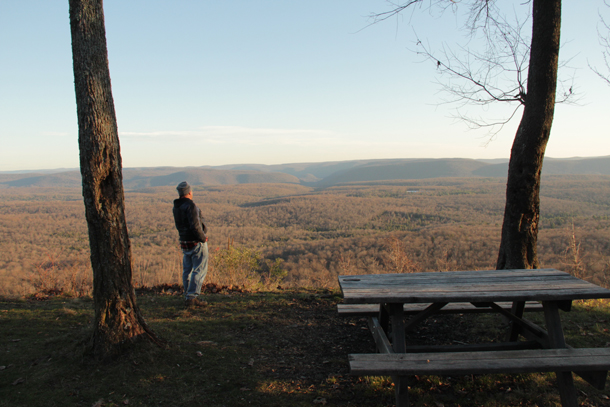
Ralph Kisberg of the Responsible Drilling Alliance, at Sharp Top vista near the Old Loggers Path. (Photo: Reid R. Frazier)
CURWOOD: And now a forest mystery. In Pennsylvania, the arrival of white pickup trucks is often the first sign that hydraulic fracturing will take place nearby. When these trucks showed up near one of the state’s best hiking trails, environmental activists and outdoor enthusiasts wanted to find out what was going on. But answers have been hard to come by from the state agency that runs the forest. As the Allegheny Front's Reid Frazier found, shedding light on what the state is planning there has been a bit like solving a whodunnit.
FRAZIER: Ralph Kisberg stands on a boulder, looking down into a series of potholes at the bottom of a crystal clear stream.
KISBERG: I guess the theory is a rock gets in there and gets swirled around, for hundreds or thousands or tens of thousands of years wears away a nice little hole in there – gets trapped.
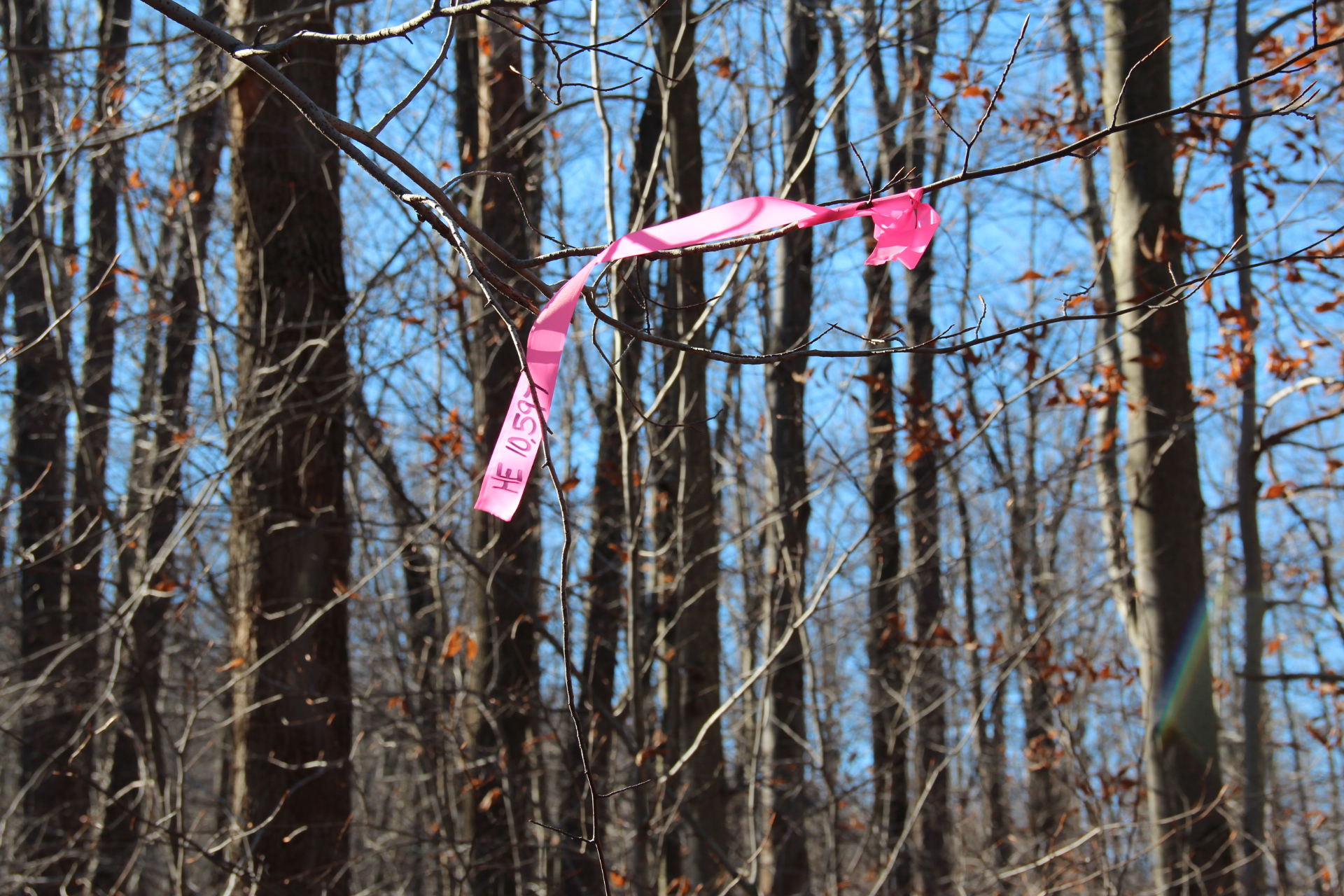
Flagging like this could mean natural gas development along the Old Loggers Path. Activists say the state could keep drillers out of the trail, if it wanted to. (Photo: Reid R. Frazier)
FRAZIER: This is Rock Run. It drains the western edge of a part of the Loyalsock State Forest called the Old Loggers Path. The path is a 27-mile loop that straddles several small mountains in the middle of Pennsylvania, and it's a favorite of backpackers and hikers. Up on the Old Logger’s Path, Kisberg has to keep a lookout so as not get lost.
KISBERG: The only problem is you got to really pay attention because this path is hard to find and hard to follow.
FRAZIER: Kisberg is head of the Responsible Drilling Alliance, an environmental group focused on natural gas development. This part of Pennsylvania, north of Williamsport, is one of the hottest drilling areas in the state – if not the country. But there’s no drilling here right now. As recently as 2008 the state touted the forest as as an area of exceptional value and beauty. Because of this, Kisberg thought the Old Logger’s Path and Rock Run would be spared from drilling. But his outlook changed not too long ago.
KISBERG: Well it was last summer, and it was someone calling me to say, what’s going on in Rock Run? There's...the frackers are up there. They’re all over the place!
FRAZIER: White trucks were running up and down the small forest roads above Rock Run. Kisberg, who lives in nearby Williamsport, went up to the forest. He realized the trucks were there to conduct seismic testing. This is like getting an X-ray to see how much gas is under ground. And it’s a first step before drilling can take place. The Department of Conservation and Natural Resources, or DCNR, is the state agency that runs the forest. The DCNR said little about what was going on in Rock Run. Kisberg wanted to find out more. So he came here.
KISBERG: It’s deeds we’re looking for…
FRAZIER: This is the Lycoming County courthouse. Kisberg learned that a man named Clarence Moore once owned the mineral rights to the Old Loggers’ Path. So with the help of a lawyer, he looked up the name.
KISBERG: Clarence Moore? Not coming up.
FRAZIER: It took a while but eventually they found documents like this one.
KISBERG: Between Penn Lyco a Maryland corporation, and John S. Williams, Frederick Maryland, and Anadarko E&P grantee...
FRAZIER: It was a sale of mineral rights to Anadarko, a big energy company. Mark Szybist is an attorney for the environmental group Penn Future. He helped Kisberg research the records.
SZYBIST: We discovered that Anadarko now owns half of the oil and gas rights under the Clarence Moore tracts.
FRAZIER: That explained the seismic testing. Anadarko has drilled dozens of deep shale wells on state forest lands. But the research turned up something else.
GREEVY: This particular land that we’re talking about, back in the day was owned by the Central Pennsylvania Lumber company.
FRAZIER: Les Greevy is an oil and gas attorney in Williamsport. Greevy says that during the Depression, the company sold the land to the state, but it kept the mineral rights. Normally, this means the company would have an unbridled right to come onto the land to drill or mine for coal. But in this case, the land was essentially put on a timer. The company would have 50 years to extract the minerals. After that, the rights of surface access for 18,000 acres of state forest – a little bit bigger than the size of Manhattan – went back to the state.
GREEVY: And if you want to come on it you’re going to have to negotiate with us, with DCNR, as to what you’re going to pay for the right to come on it and what the conditions are going to be.
FRAZIER: Eventually, Clarence Moore bought the mineral rights to the land. And after the 50 year period expired, Moore tried to regain surface access. But in 1989, a court rebuffed him. It said the DCNR could keep drillers off the land if it wanted to. But that isn't how the agency sees it now. Chris Novak is the DCNR’s press secretary.
NOVAK: As the law applies, DCNR can’t prohibit access to subsurface mineral rights if we don’t own them.
FRAZIER: Other DCNR officials have said Anadarko and other companies could sue the agency if it tries to keep the company off the Old Loggers’ Path. Novak and the DCNR remain tight-lipped about the agency’s discussions with Anadarko. But Kisberg and others grew alarmed last year when survey markers for what looked like well pad sites began showing up in the forest. And records obtained by the Responsible Drilling Alliance through right to know requests raised alarms even more. They revealed Anadarko has been talking with the state about a development plan for the forest for much of the past year. The details of those plans, however, remain unclear. An Anadarko spokeswoman would only say that no development plans had been approved. These cagey answers from the state bug Mark Szybist, the Penn Future attorney.
SZYBIST: It’s not right for DCNR to be making these decisions on its own without any public review of the documents. You know, if DCNR is so confident that it’s going to make the right decision, then why not let the public look over its shoulder a little bit, and have a seat at the table?
FRAZIER: The DCNR counters that the state simply doesn’t do public reviews of drilling plans on public land. The debate is only heightened because the state has already leased 700,000 acres of forest land – that’s a third of the entire state forest system. That means that places like the Old Loggers’ Path are becoming increasingly rare, says Paul Zeph, of the Audubon Society.
ZEPH: This is one of the places in the state that should be off limits.
FRAZIER: Zeph says this in spite of the fact that the Old Loggers’ Path has been mined and timbered in the past. But the forest is unique because numerous springs and seeps keep it wet. That’s good for bugs, and the bugs are good food for migratory songbirds who nest there. Plus the forest is quiet, and the birds like that. No matter how careful DCNR and Anadarko plan the development, drilling is loud and disruptive. And Zeph says, it would chase away some of these birds.
ZEPH: ...and there’s nowhere else in Pennsylvania for them to go.
FRAZIER: For now the fate of this trail lies in the state capital of Harrisburg. Whatever happens there, it won’t be a mystery for very long.
For Living on Earth, I’m Reid Frazier, in Williamsport, Pennsylvania.
CURWOOD: Our story on the Old Loggers' Trail comes to us by way of Pennsylvania’s public radio program, The Allegheny Front.
Related links:
- More about Loyalsock State Forest
- More about the Allegheny Front
[MUSIC: Bill Frisell “Give Me A Holler” from Nashville (Nonesuch records 1997)]
CURWOOD: Coming up...the world’s largest and perhaps oldest organism – and why it's under threat. That's just ahead on Living on Earth.
ANNOUNCER: Funding for Living on Earth comes from the Grantham Foundation for the protection of the environment. Supporting strategic communications and collaboration in solving the world’s most pressing environmental problems. The Gordon and Betty Moore Foundation. The Kendeda Fund, furthering the values that contribute to a healthy planet, and Gilman Ordway, for coverage of conservation and environmental change. This is PRI, Public Radio International.
[CUTAWAY MUSIC: Jenny Scheinman: “A Ride With Polly Jean” from Mayhem And Mischeif (Jenny Scheinman 2011)]
Burning! A Longer US Fire Season May Be the New Normal

Late season high altitude fires were unheard of in the past. (National Park Service)
CURWOOD: It's Living On Earth, I'm Steve Curwood. As well as being the hottest year on record, 2012 was one of the worst on record for forest fires. That's according to a report from the National Climate Data Center that chronicled over 9 million acres of forest burned in the US, one and a half times the average.
Scientists estimate that the fire season now lasts 75 days longer than it did 40 years ago. In 2012, there were fires in places researchers thought would never burn, including parts of Rocky Mountain National Park in Colorado. One expert on western forest fires is Jason Sibold. He teaches geography at Colorado State University and says he knows what's causing the change.
SIBOLD: This is a climate driven-system that we’re talking about. Over the last couple decades in the Rockies and in the west in general we see that not just temperature, but snowpack is really driving this change in forest fires. Our snowpack is not as deep and it's melting out at an earlier and earlier date, and this is really critical.
A lot of the forest fires we had in the summer oftentimes have snow lingering well into June and maybe even early July. And now we have these areas that are snow-free in April, mid-April, and it allows them to start drying out. If we start to lengthen that fire season by melting that snow earlier either through whatever – combination of warmer temperatures, less precipitation, rain on snow – whatever it is, that that lengthening of the fire season is the driver of these large fire years.

The Fern Lake fire in Rocky Mountain National Park (National Park Service)
CURWOOD: Now, Professor Silbold, you’ve done research on Fern Lake, that's part of Rocky Mountain National Park there in Colorado where there was a big fire last year. I understand it was unexpected to have a fire there. Can you tell me about that?
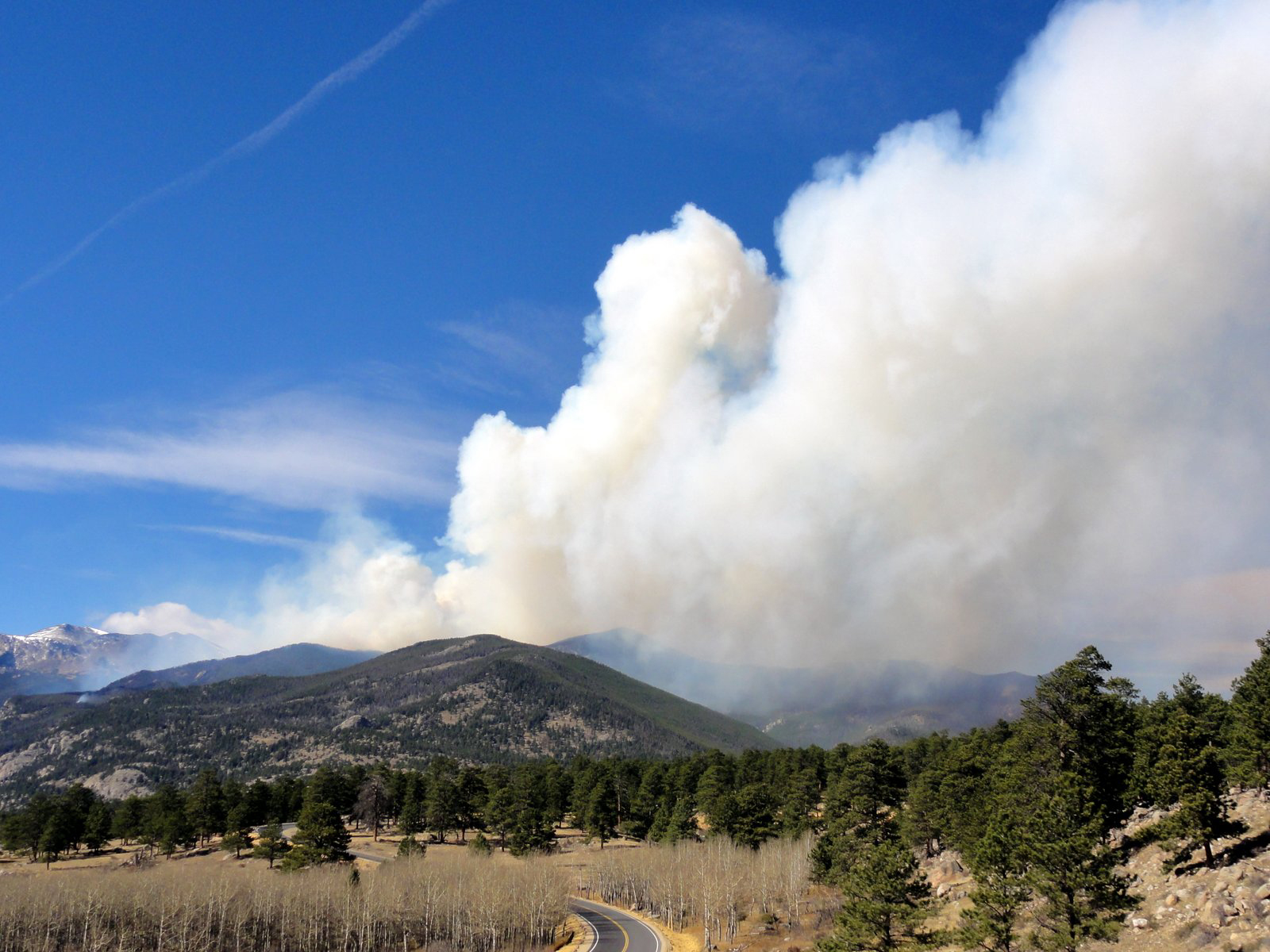
Smoke from the Fern Lake fire in Colorado’s Rocky Mountain National Park. (National Park Service)
SIBOLD: Yes, this Fern Lake fire in Rocky Mountain National Park, in a part of the park called Forest Canyon, that started actually in October when we would normally think of this high elevation, very wet, shaded deep valley as being under you know maybe 1, 2 meters of snow in the fall. And it burned throughout the fall. It started in October...to tell you the truth I just got a report that it’s still smoldering. So our fire season, our 2012 fire season in reality still hasn't stopped.
And the really unusual thing about the Fern Lake fire in Forest Canyon is that there's really no evidence of past fires. When we core trees there are a lot of very old trees, and when I say very old trees, I mean 600, 700-year-old trees are abundant in this valley. None of them are indicating that we have any fire within the last 800 years at least, and then if you start poking around and kicking around in the dirt and rocks and you’re looking for charcoal, for example, for some indication of some past fire further back in time maybe a couple thousand years or something, you just don't find that. So we've got this Fern Lake fire in Forest Canyon that’s burning in a very unlikely place, much less an unlikely time of year.
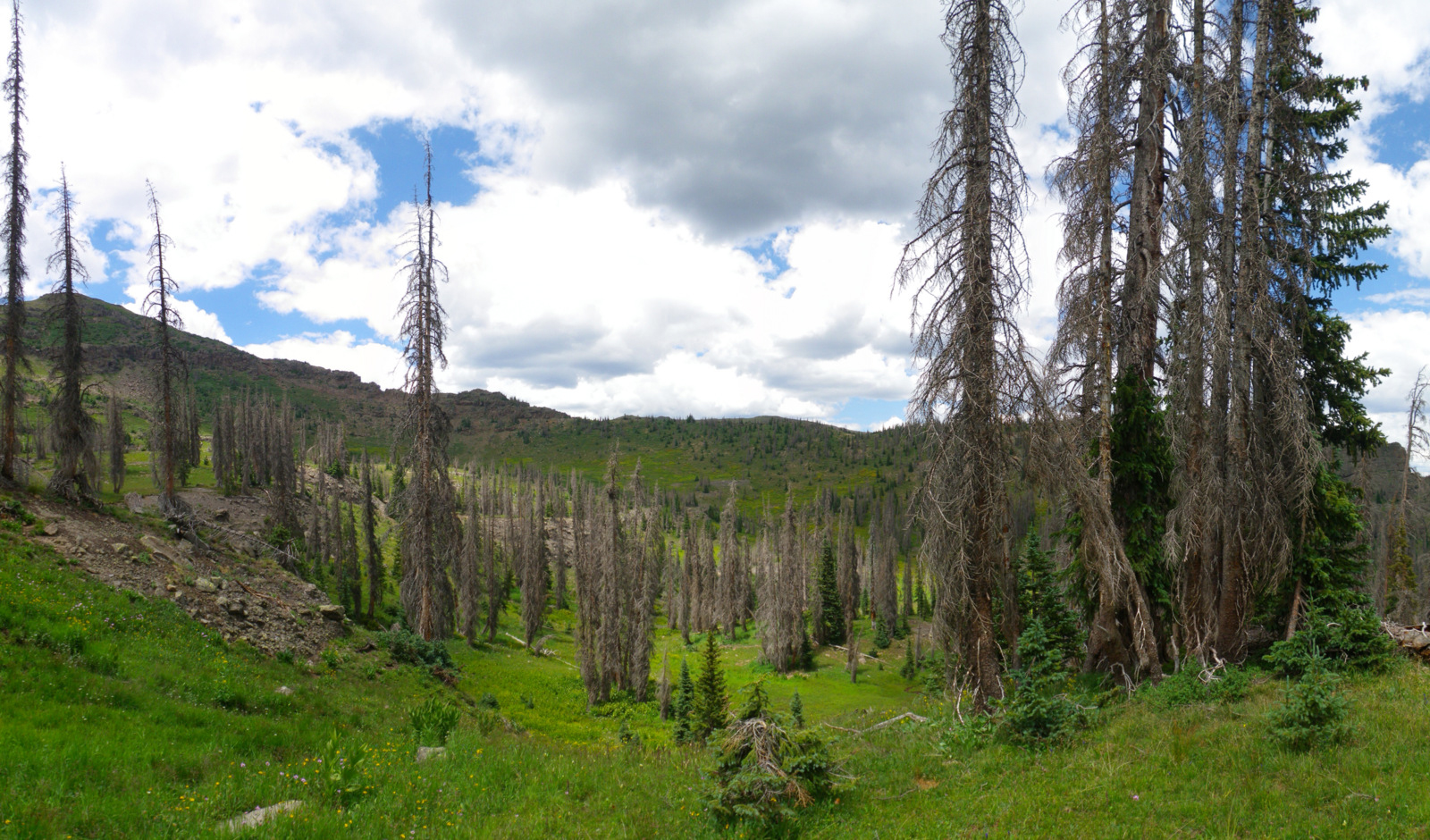
The ongoing outbreak has also affected treeline forests where advanced regeneration is less common. Weminche Wilderness, CO. (Photo: David Scott)
CURWOOD: So how can trees survive these changing conditions? What should we expect in terms of seeing perhaps a shift in the kinds of trees that can live in the southwestern Rocky Mountains.
SIBOLD: In theory, trees will start to move around and they will find their new places where they can survive in a new climate scenario. The big questions are - and we know that trees have done this in the past, following glaciations, for example - the big difference that we have today is these trees have a lot of factors going on, probably the most concerning of which is the rate of change that is projected in this century.
Trees are not all that great of migrating long distances very quickly. The other thing is that we've got this highly altered landscape. We’ve got roads and parking lots and towns and ski areas and you name it. And these species may find their ideal new spot to reestablish themselves, but if there's a parking lot there, or there's a road in the way, this is going to make things very challenging.
CURWOOD: Tell me about the beetles. How big a factor are they in forest fires?

Beetle-killed spruce forest in the Weminuche Wilderness, CO. (Photo: David Scott)
SIBOLD: There are definitely relationships between beetles and forest fires. We’ve had extensive beetle outbreaks across the Rockies, across most of the west in the last two decades. At first, there's just thought that, well, all this dead fuel...it must be more flammable. When I build a campfire or something, I use dead trees, right, I don't use live trees. But when we really start to study this, it just doesn’t hold true.
With wildfires, the mass of these live fuels is held up in the canopy, and these canopy trees even when they're alive, if they’re dry enough and it's hot enough, they become extremely flammable. The needles, the twigs, the really small stuff, becomes extremely flammable. And the beetles, in reality, once they kill a tree, all of those fine fuels are moving from the canopy, a place where they can be highly flammable, they're moving to the forest floor. They’re compacting, and they're not quite as flammable; they're holding their moisture longer. And we're left with that ball of that tree that’s just not as flammable as a really dry live tree. So beetles are not just a big factor in what we're seeing. What we're seeing is climate, climate, climate.
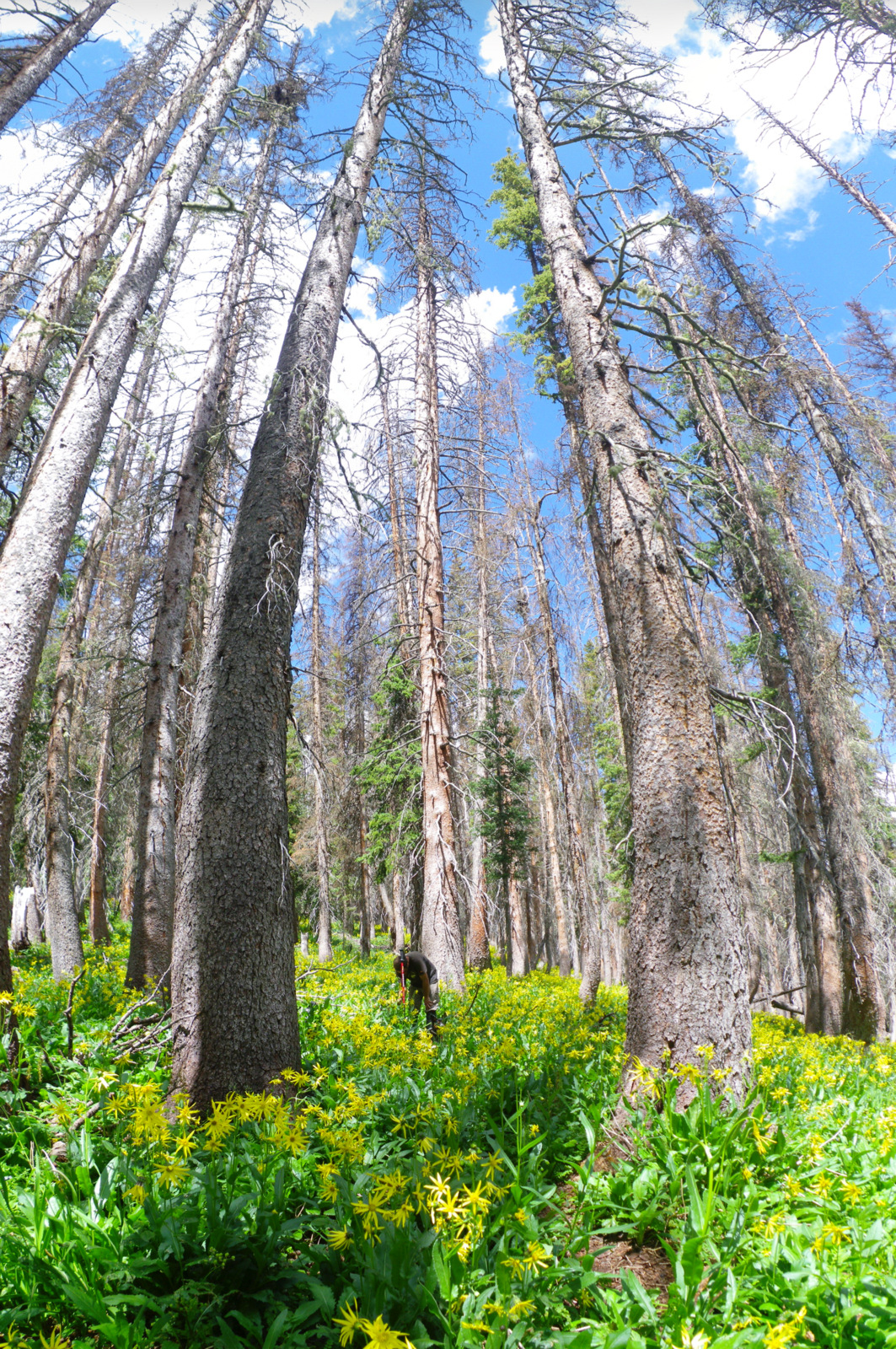
When significant numbers of canopy trees are killed, understory plants flourish due to increases in the amount of sunlight reaching the forest floor. South San Juan Wilderness, CO.(Photo: David Scott)
CURWOOD: So don’t blame the Spruce Bud Worm, don’t blame the Pine Bark Beetle, blame anthropogenic climate change.
SIBOLD: As always we get into these tricky situations where it's difficult to pull out of a summer like 2012 and say this is anthropogenic climate change. But this isn’t a one-year event. This isn’t a Katrina or a Sandy were it’s even harder to pin it on things like, you know ,anthropogenic climate change. We've got a few too many things adding up to start saying, hey, this is just a little normal swing in climate and we're going to go back. We're looking at what are projected to be, more or less, our average climate conditions by mid century. It's not that far away. This is our new normal. This is our future. We're here. We’re looking at what we need to be thinking about for the next few decades.

(National Park Service)
CURWOOD: Jason Sibold teaches at Colorado State University in Fort Collins, Colorado. Thank you so much for taking the time today.
SIBOLD: Thanks so much, Steve.
Related links:
- National Climatic Data Center 2012 Fire Report
- More abut Jason Sibold
The World's Largest Known Organism In Trouble
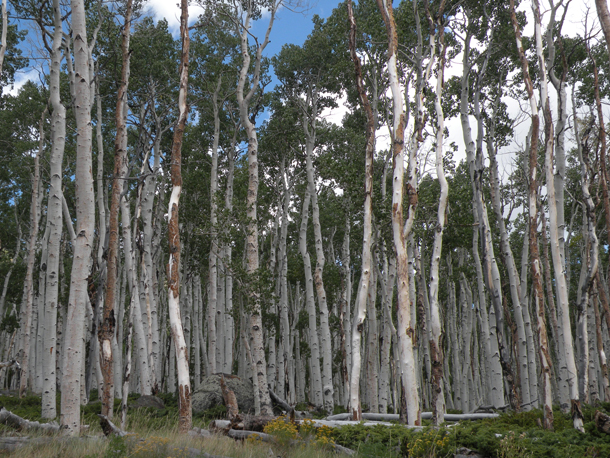
A small section of Pando. (Photo: Paul C. Rogers, Western Aspen Alliance)
CURWOOD: Quick quiz. Now what’s the largest living organism on Earth? No, it’s not a blue whale. It’s a tree, a Quaking Aspen. That's right, a single Quaking Aspen in Utah covers 106 acres of land and is estimated to weigh more than 6,000 metric tonnes.
Aspen trees flourish in much of North America, but in the western US a genetic adaptation allows them to propagate not by seed, but by cloning. By some estimations the Aspen grove known as Pando, that's Latin for I spread, could be shoots from a clone as much as 80,000 years old.
That means it started sprouting when modern humans were migrating out of Africa. But the world’s largest organism is now under threat. Here to explain why are Paul Rogers, Director of the Western Aspen Alliance at Utah State University and Karen Mock, Professor of Conservation Genetics and Molecular Ecology at USU.
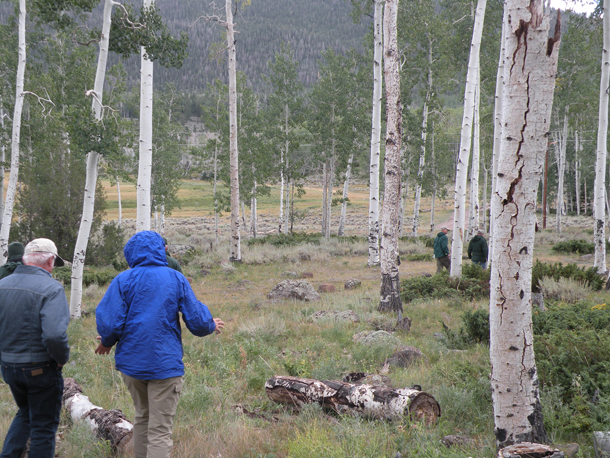
The Pando aspen clone is nearly devoid of young and middle-aged trees as a result of ongoing browsing, reducing the overall resilience of this long-lived organism. (Photo: Paul C. Rogers, Western Aspen Alliance)
MOCK: Aspen, as a species, has two basic ways of reproducing. One is by seed and one is by root shoots, and if you're talking about a single clone or single genetic individual like Pando, then that is ...you’re probably looking at roots that sprout from pre-existing trees.
CURWOOD: Now why do western Aspens reproduce this way, but the ones that we have out east don’t?
MOCK: Well, they actually both, all across the range, they reproduce both asexually and sexually. It’s just a matter of proportion. And so in the east, in northern environments, it appears that they see reproduction as a whole lot more common. And therefore, the clones tend to be smaller. In the west, seed reproduction is a little more episodic. Seed reproduction is not as common as it is in moister landscapes.
CURWOOD: So it's a matter that it's too dry then.
MOCK: Yes, and the opportunities for seeding, the conditions that are just right for seeding, don't always occur together at the same time as you have seeds.
CURWOOD: But is Pando a girl tree or a guy tree?
MOCK: [LAUGHS} It’s a male.
CURWOOD: So Pando is a male Aspen, but really at the day is essentially sterile.
MOCK: Yes, it's apparently triploid, which means it's got three copies of its chromosomes instead of usual two in Aspen, and that condition means that it can do just fine vegetatively, but when it comes time to produce, in this case, pollen, the pollen grains are not likely to lead to the production of seed.
CURWOOD: In terms of evolution how smart is this for a plant to not be able to reproduce sexually?
MOCK: Well, as a single plant it's probably, especially in the west, it's probably great insurance so that you can persist a long time and in certain landscapes in between these episodes of sexual reproduction. As a population, it's a little bit more questionable because, you, as a population, if you lack genetic diversity you really are at risk of not being to adapt to changing conditions.
CURWOOD: So how are scientists able to estimate Pando’s age? I hear that this could be as much as 80,000 years old, but there’s not exactly any individual trees available for counting the rings there, right?
MOCK: We all wish we knew the exact age of Pando or had some tool that we could use to get precise ages on certain clones. We really don't know the age. The 80,000 years was a estimate based on really the rates of expansion of Aspen as well as backward projections of what climates were thought to be like. And so that's a super rough estimate. We don't really have a good way to know that it's 80,000 years old.
CURWOOD: Paul Rogers, Pando isn't doing so well right now though. What’s going on?
ROGERS: Well, that's correct, Steve. Right now we have a lot of mature trees; most of the stems are about 130 years old and Aspen typically lives about 100 years, give or take a 50 year period. So at any rate, around that period where we would expect the stems to be dying off, the issue here with Pando currently is that there's very little to replace it. So we have almost no vertical diversity - if you think of a human population you might think of toddlers, teenagers, middle-age people, and mature adults – to be sensitive there – and what we have is a lot of mature adults that are starting to die fairly rapidly, but we don't have those extra generations to back them up. So that's the key to the problem there.
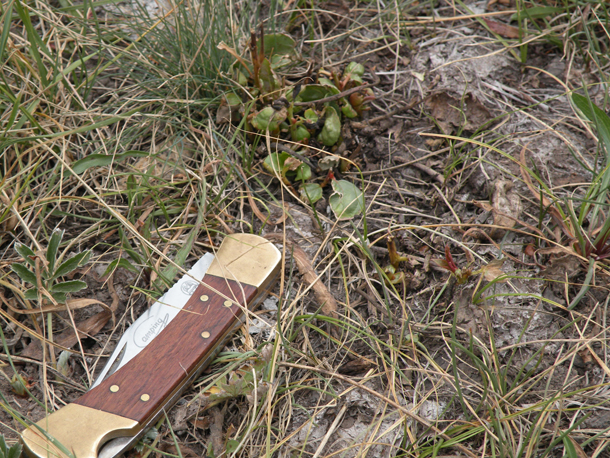
A tiny aspen stem, which sprouts from the larger clone's roots, has been browsed several times as evidenced by the small stature and bushy appearance. (Photo: Paul C. Rogers, Western Aspen Alliance)
CURWOOD: So what are the stressors for Pando now?
ROGERS: There's continual browsing of the young shoots, and these are very nutritious, very edible and primarily to larger browsers – both domestic and wild. So we have elk, deer, sheep, and cattle are the main culprits across the west, but we have to note here that Pando and a lot of Aspen in Southern Utah are growing in a fairly dry climate, so the reproduction is fairly slow as it is. And so even a small number of browsers, in this case, we think, deer, can really keep the next generation or the next set of stems at bay; and that looks like the situation that we have on the ground now.
CURWOOD: I understand that you're working on the idea of putting a fence around Pando to keep out the grazing animals. How's that working out?
ROGERS: Well, that's correct. This sort of rapid die-off of mature trees has brought us into a triage mode, you might say with the Pando clone, and that we are planning to put up an initial set of fences around about half the clones this coming summer. The US Forest Service is really instrumental in having all that done because it’s in a touristy area near a recreational lake, and it's also a tourist attraction in and of itself, the Pando clone.
CURWOOD: And who’s going to watch the fence, I mean, if there’s a hole in the fence, the elk will find there’s good eating.
ROGERS: You’re exactly right. So if you can imagine yourself sort of walking down the street and you look into an ice cream store and, there’s no ice cream out in the street, and it's a hot summer day, that's kind of, I think, what the browsers, the deer and elk are seeing inside that fence. And so if there's a breach, even one breach for a few days or week in the fence – and this is a lot more common than folks might think – the trees fall down and they fall over the fence and animals get in and they can eat everything. So you could lose essentially a year or more of trying to protect this clone with one or two small breaches and a week or two going by.
CURWOOD: And if your deer are anything like our deer out here in the east, they can jump!
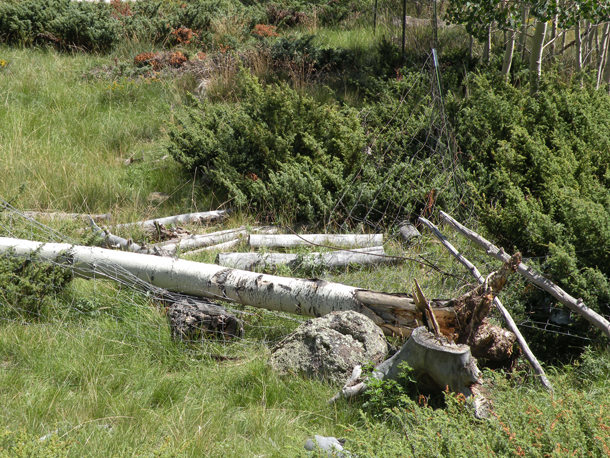
Recently fallen tree breaches inside the existing aspen fence allow browsers, such as deer, elk, and cattle, to consume protected new growth. A plan to fence much larger sections of Pando will be initiated by the US Forest Service summer 2013. (Photo: Paul C. Rogers, Western Aspen Alliance.)
ROGERS: That's true and you know I found out they can get under the fences too. They are quite crafty and some of these deer have gotten trapped in there, and then it’s unhealthy for the deer as well because there's not a water source in there, and they can be essentially caged in.
CURWOOD: Could there be there are not enough wolves?
ROGERS: That could be that there's not predators. That's certainly a factor in there but we also have this whole system pushed further to the edge because of climate. So we feel like we’re accelerating the rate of die-off for the mature trees. And the more mature trees that are dead, the engine underground, which is the root system, has less energy to push up new recruits.
CURWOOD: I understand this is the largest known Aspen clone, but, of course, that doesn't mean there aren't bigger ones out there. Where you guys looking for them?
MOCK: We don't haven't a program where we’re actively looking for large clones. Both of our guesses are that there are probably larger clones out there, but there's not a systematic survey going on to find such a thing. This clone was probably discovered because the road goes right through the middle of it. It also has some morphological differences, and differences in the leaves and the stems from the adjacent clones. And so the boundaries are pretty easy to see.
CURWOOD: So when the leaves come out in the spring, do they all come out at the same time?
MOCK: Basically, yes, it is a little bit dependent on the size of the particular tree, but that is one of the most reliable ways to actually distinguish different clones because their timing and their day-length perceptions does tend to be a little bit different.
CURWOOD: And then at the end of the season, they pretty much drop the leaves at the same time, or change color at the same time?
MOCK: They do, but it's pretty striking. You can look up across these western landscapes and see very clear outlines of different leaf colors. It’s very dramatic and beautiful.
CURWOOD: Tell me what it was like when you first saw Pando?
ROGERS: That's a great question, Steve. The first time I went there, I actually saw one of those deer caught inside the fence. And the Forest Service individual who was giving us the tour was sort of embarrassed. But what I saw there was a very dry forest. We walked all through it, and this was only about five years ago. We didn't see near the rate of the overstory or the mature trees dying as we do now, so something seems to be happening there fairly quickly, and perhaps there's some sort of threshold that’s been crossed in terms of drought, and insects and disease. I mean, we can fence it off, but we cannot fence all the western landscape. Really it's a microcosm for a much larger problem, particularly in the southwest, but in many parts of the western states.
Karen, what was it like when you first saw Pando?
MOSS: Oh, to me it’s philosophically...it’s just sort of a mind-blowing issue that you could have that many trees come from one seed and live for such a long time. Really, I think it challenges our notions of both individuality and mortality. And it’s kind of fun to be challenged that way.
CURWOOD: Karen Mock is a Professor of Molecular Ecology at Utah State University, and Paul Rogers is the Director of the Western Aspen Alliance at USU. Thank you both for taking this time.
ROBERS: Thanks for having us on, Steve.
MOCK: Thanks so much.
Related links:
- Western Aspen Alliance
- More about Paul C. Rogers
- More about Karen Mock
- Leaf and Limb blog: The World's Oldest Trees
- Wired: The Oldest Trees on the Planet
[MUSIC: Quaking Aspens: Various Artists/Euphoria “Desert Drive” from Eden: A Collection Of Global Chill (Six Degrees records 2006)]
CURWOOD: Living on Earth is produced by the World Media Foundation. Bobby Bascomb, Emmett Fitzgerald, Helen Palmer, Annie Sneed, Adelaide Chen, James Curwood and Gabriela Romanow all help to make our show. Jeff Turton is our technical director. Alison Lirish Dean composed our themes. You can find us anytime at LOE.org, and check out our Facebook page. It’s PRI’s Living on Earth. I'm Steve Curwood. Thanks for listening.
ANNOUNCER: Funding for Living on Earth comes from Stonyfield Farm, makers of organic yogurt, smoothies, and more. Stonyfield invites you to just eat organic for a day. Details at justeatorganic.com. Support also comes from you, our listeners. The Go Forward Fund and Pax World Mutual and Exchange Traded Funds, integrating environmental, social and governance factors into investment analysis and decision making. On the web at PaxWorld.com. PaxWorld, for tomorrow.
ANNOUNCER 2: PRI Public Radio International.
Living on Earth wants to hear from you!
Living on Earth
62 Calef Highway, Suite 212
Lee, NH 03861
Telephone: 617-287-4121
E-mail: comments@loe.org
Newsletter [Click here]
Donate to Living on Earth!
Living on Earth is an independent media program and relies entirely on contributions from listeners and institutions supporting public service. Please donate now to preserve an independent environmental voice.
NewsletterLiving on Earth offers a weekly delivery of the show's rundown to your mailbox. Sign up for our newsletter today!
 Sailors For The Sea: Be the change you want to sea.
Sailors For The Sea: Be the change you want to sea.
 The Grantham Foundation for the Protection of the Environment: Committed to protecting and improving the health of the global environment.
The Grantham Foundation for the Protection of the Environment: Committed to protecting and improving the health of the global environment.
 Contribute to Living on Earth and receive, as our gift to you, an archival print of one of Mark Seth Lender's extraordinary wildlife photographs. Follow the link to see Mark's current collection of photographs.
Contribute to Living on Earth and receive, as our gift to you, an archival print of one of Mark Seth Lender's extraordinary wildlife photographs. Follow the link to see Mark's current collection of photographs.
 Buy a signed copy of Mark Seth Lender's book Smeagull the Seagull & support Living on Earth
Buy a signed copy of Mark Seth Lender's book Smeagull the Seagull & support Living on Earth

